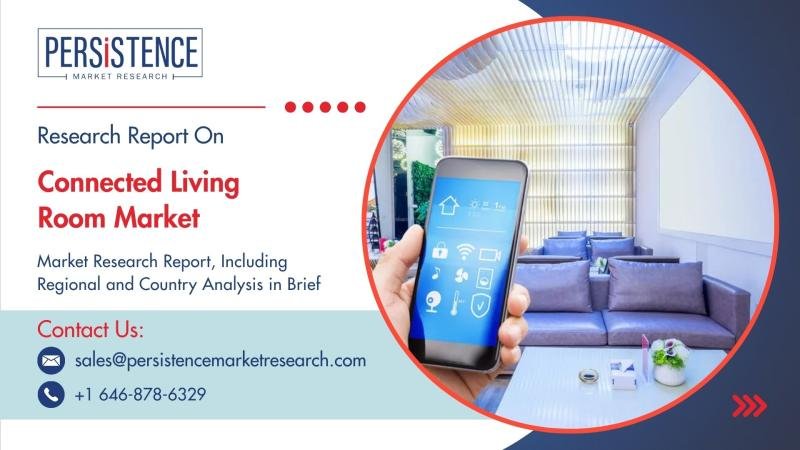✅ Overview of the Connected Living Room Market
The connected living room market is undergoing a rapid transformation, driven by technological advancements and changing consumer lifestyles. As digitalization deepens and home entertainment becomes more immersive, the integration of smart devices in living rooms is no longer a luxury-it’s a norm. According to Persistence Market Research, the global connected living room market is expected to grow from US$ 60.57 billion in 2025 to US$ 106.8 billion by 2032, reflecting a CAGR of 8.5% over the forecast period.
One of the primary growth drivers is the rising demand for seamless and interconnected home entertainment systems. Consumers are increasingly adopting smart TVs, gaming consoles, smart speakers, and streaming devices to create fully immersive media environments. Smart TVs are currently the leading segment, thanks to advancements in 4K, OLED, and AI-based content recommendations. In terms of regional leadership, North America dominates the global market, supported by high consumer awareness, technological infrastructure, and wide adoption of IoT-enabled devices. Meanwhile, Asia Pacific is catching up fast, fueled by growing middle-class income, increasing internet penetration, and aggressive smart home initiatives across countries like China, South Korea, and Japan.
Get a Sample PDF Brochure of the Report (Use Corporate Email ID for a Quick Response): https://www.persistencemarketresearch.com/samples/10840
✅ Key Highlights from the Report
➤ The connected living room market is projected to reach US$ 106.8 Bn by 2032.
➤ Smart TVs remain the dominant product segment due to high demand for content streaming.
➤ North America leads the market, followed by Asia Pacific with strong growth potential.
➤ Home entertainment and media streaming are the largest applications in the market.
➤ Integration of smart lighting and voice assistants is gaining significant traction.
➤ Wi-Fi remains the primary connectivity technology in the connected living room ecosystem.
✅ Market Segmentation Analysis
The connected living room market segmentation provides insights into how consumer preferences and technological trends are shaping product development and sales strategies. By product type, the market includes a wide range of devices: Smart TVs, streaming devices, set-top boxes (STBs), gaming consoles, smartphones and tablets, smart speakers, smart lighting, and home theater systems. Among these, smart TVs hold the largest share, supported by the rise of OTT platforms and improved display and connectivity features. Streaming devices like Roku, Chromecast, and Fire TV are also witnessing steady growth as they turn ordinary televisions into smart hubs.
From a technology perspective, the market is segmented into Wi-Fi, Bluetooth, Zigbee, Z-Wave, and others. Wi-Fi leads this category as it is the most accessible and cost-effective method for seamless data transmission and device connectivity. However, technologies like Zigbee and Z-Wave are increasingly being adopted for smart home automation and device control, offering low-energy, secure mesh networks for lighting and climate control systems.
On the basis of application, the market is categorized into home entertainment & media streaming, home automation & control, gaming & e-sports, and others. Home entertainment and media streaming is the dominant segment, largely due to the boom in video-on-demand services, live streaming platforms, and multi-device viewing. As gaming becomes more social and immersive, the gaming & e-sports segment is also showing significant promise, particularly among Gen Z consumers.
✅ Regional Insights
North America currently leads the connected living room market, underpinned by high consumer tech adoption, widespread internet connectivity, and robust smart home infrastructure. The U.S., in particular, has become a hub for innovation in connected devices, driven by companies like Google, Amazon, and Apple. Consumers in this region are willing to invest in the latest technologies to elevate their home entertainment experiences, whether through ultra-HD TVs or AI-powered voice assistants like Alexa or Siri.
Meanwhile, Asia Pacific is emerging as the fastest-growing region. Countries such as China, India, Japan, and South Korea are experiencing a surge in demand for smart living solutions due to urbanization, improved disposable income, and government-led digital transformation initiatives. Local companies like Xiaomi and TCL are also playing a pivotal role by offering affordable, high-quality smart devices tailored to regional needs. The increasing rollout of 5G networks is expected to further boost market growth in this region.
✅ Market Drivers
Several factors are propelling the growth of the connected living room market. First and foremost is the increasing penetration of high-speed internet and the availability of affordable smart devices, which make it easier for consumers to set up interconnected ecosystems. The rise of subscription-based OTT platforms has also redefined content consumption habits, driving the demand for smart TVs and streaming devices. Furthermore, voice assistants and AI-integrated smart home gadgets are transforming how users interact with their living spaces, adding convenience and personalized experiences. With the onset of hybrid work models, consumers are also upgrading their home setups, further accelerating adoption.
✅ Market Restraints
Despite its promising outlook, the market faces several challenges and constraints. High initial setup costs for a fully connected living room remain a significant barrier, particularly in developing regions. Additionally, compatibility issues between devices from different manufacturers can hinder seamless integration, frustrating consumers who expect plug-and-play experiences. Privacy and data security concerns are also rising as more devices collect user data, prompting consumers to question the trade-off between convenience and surveillance. Moreover, technical complexities and a lack of consumer awareness in certain markets may slow down the adoption of advanced connected systems.
✅ Market Opportunities
There are ample opportunities for innovation and expansion in the connected living room market. One of the most promising avenues is AI-driven personalization, where smart devices learn user preferences to offer tailored content, lighting, and climate settings. Integration with smart home ecosystems, including smart thermostats, security cameras, and smart appliances, opens new possibilities for holistic living experiences. The ongoing 5G rollout will further enhance connectivity and device synchronization, offering near-zero latency for applications like gaming and real-time content streaming. There’s also a growing market for eco-friendly and energy-efficient smart devices, aligning with global sustainability goals.
For Customized Insights on Segments, Regions, or Competitors, Request Personalized Purchase Options@ https://www.persistencemarketresearch.com/request-customization/10840
✅ Frequently Asked Questions
➤ How Big is the Connected Living Room Market projected to be by 2032?
➤ Who are the Key Players in the Global Connected Living Room Market?
➤ What is the Projected Growth Rate of the Connected Living Room Market during the forecast period?
➤ What is the Market Forecast for Connected Living Room Market by 2032?
➤ Which Region is estimated to dominate the Connected Living Room Industry through the Forecast Period?
✅ Company Insights
✦ Samsung Electronics
✦ LG Electronics
✦ Sony Corporation
✦ Apple Inc.
✦ Google LLC
✦ Honeywell International Inc.
✦ Amazon
✦ Panasonic Corporation
✦ Xiaomi Corporation
✦ Bose Corporation
✦ Lutron Electronics
✦ TCL Technology
✅ Recent Developments
■ In 2024, Samsung Electronics launched a new line of AI-powered Smart TVs designed to enhance content curation and multi-device integration in smart living rooms.
■ Apple Inc. announced upgraded support for Matter-enabled devices in its HomeKit ecosystem, improving interoperability in connected home setups.
This detailed overview of the connected living room market reflects how smart technologies are reshaping domestic life. As innovation continues to evolve and consumer expectations rise, the living room is poised to become the central hub of tomorrow’s digital home.
Explore the Latest Trending “Exclusive Article” @
• https://techxpresstoday.wordpress.com/2025/05/14/microscope-camera-market-research-highlights-regional-insights/
• https://www.linkedin.com/pulse/microscope-camera-market-growth-trends-future-outlook-2025-svsuf/
• https://medium.com/@apnewsmedia/microscope-camera-market-analysis-reveals-key-industry-drivers-563803b09ef1
• https://webrankmedia.blogspot.com/2025/05/microscope-camera-market-demand-surges.html
Contact Us:
Persistence Market Research
G04 Golden Mile House, Clayponds Lane
Brentford, London, TW8 0GU UK
USA Phone: +1 646-878-6329
UK Phone: +44 203-837-5656
Email: sales@persistencemarketresearch.com
Web: https://www.persistencemarketresearch.com
About Persistence Market Research:
At Persistence Market Research, we specialize in creating research studies that serve as strategic tools for driving business growth. Established as a proprietary firm in 2012, we have evolved into a registered company in England and Wales in 2023 under the name Persistence Research & Consultancy Services Ltd. With a solid foundation, we have completed over 3600 custom and syndicate market research projects, and delivered more than 2700 projects for other leading market research companies’ clients.
Our approach combines traditional market research methods with modern tools to offer comprehensive research solutions. With a decade of experience, we pride ourselves on deriving actionable insights from data to help businesses stay ahead of the competition. Our client base spans multinational corporations, leading consulting firms, investment funds, and government departments. A significant portion of our sales comes from repeat clients, a testament to the value and trust we’ve built over the years.
This release was published on openPR.














